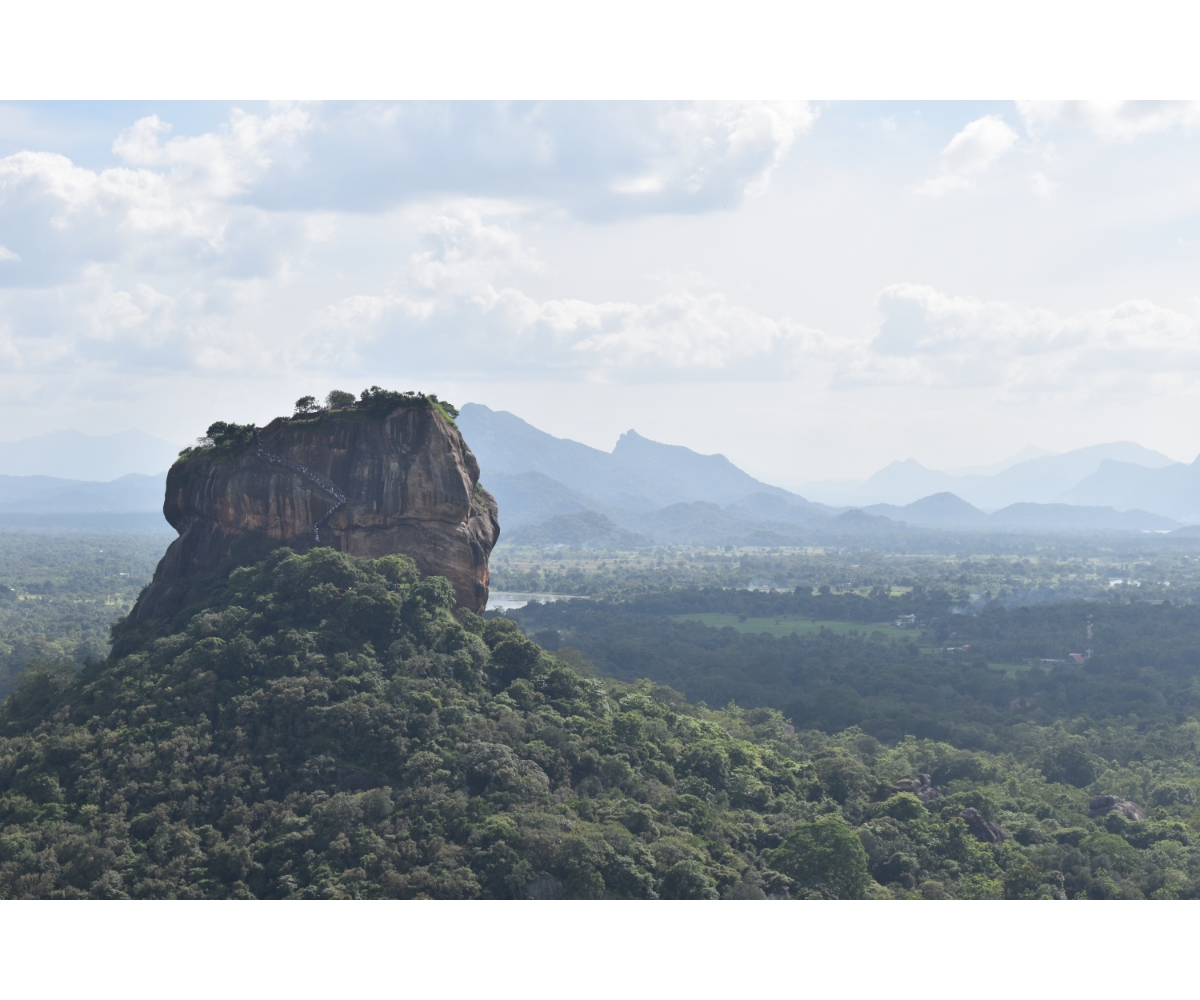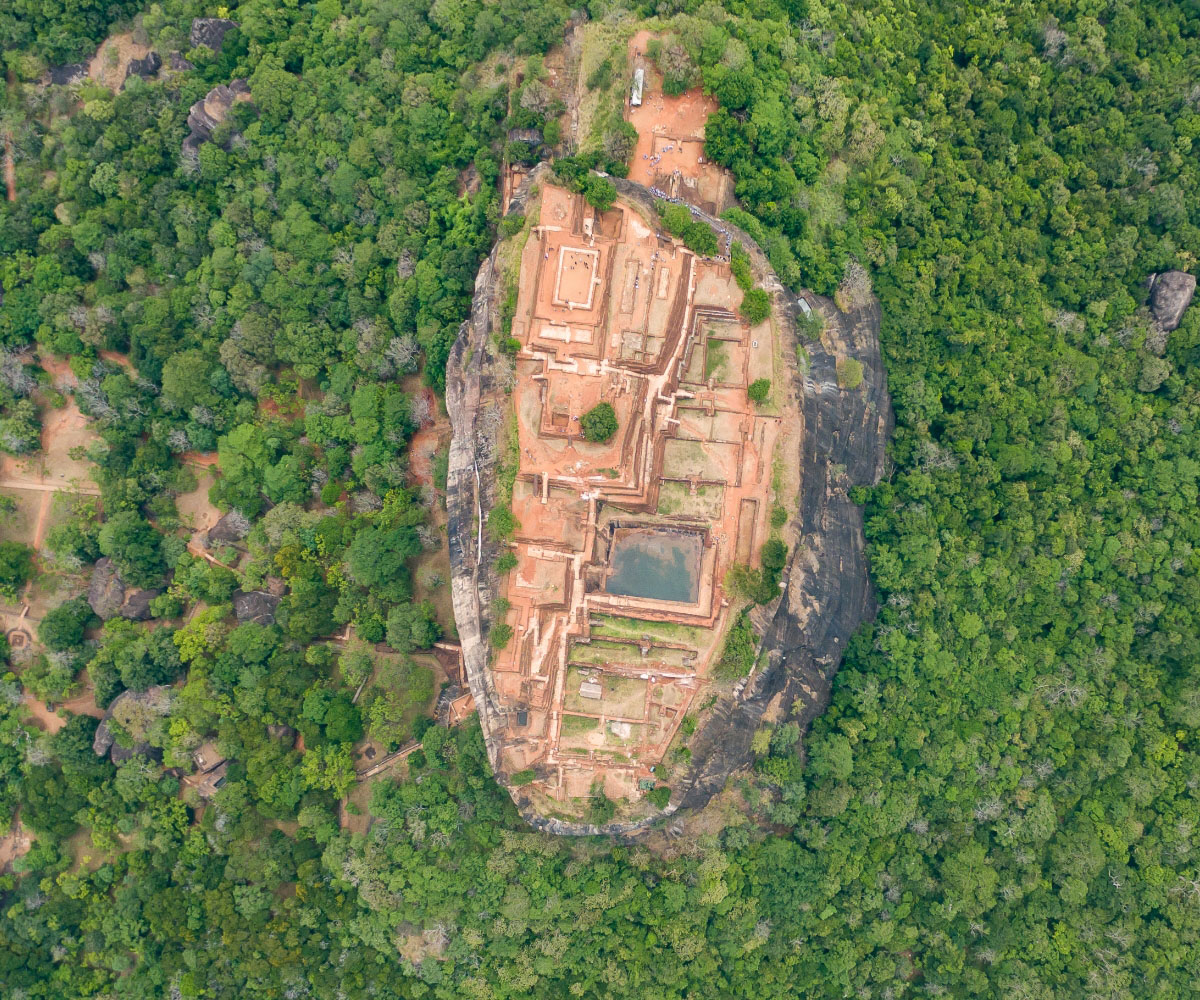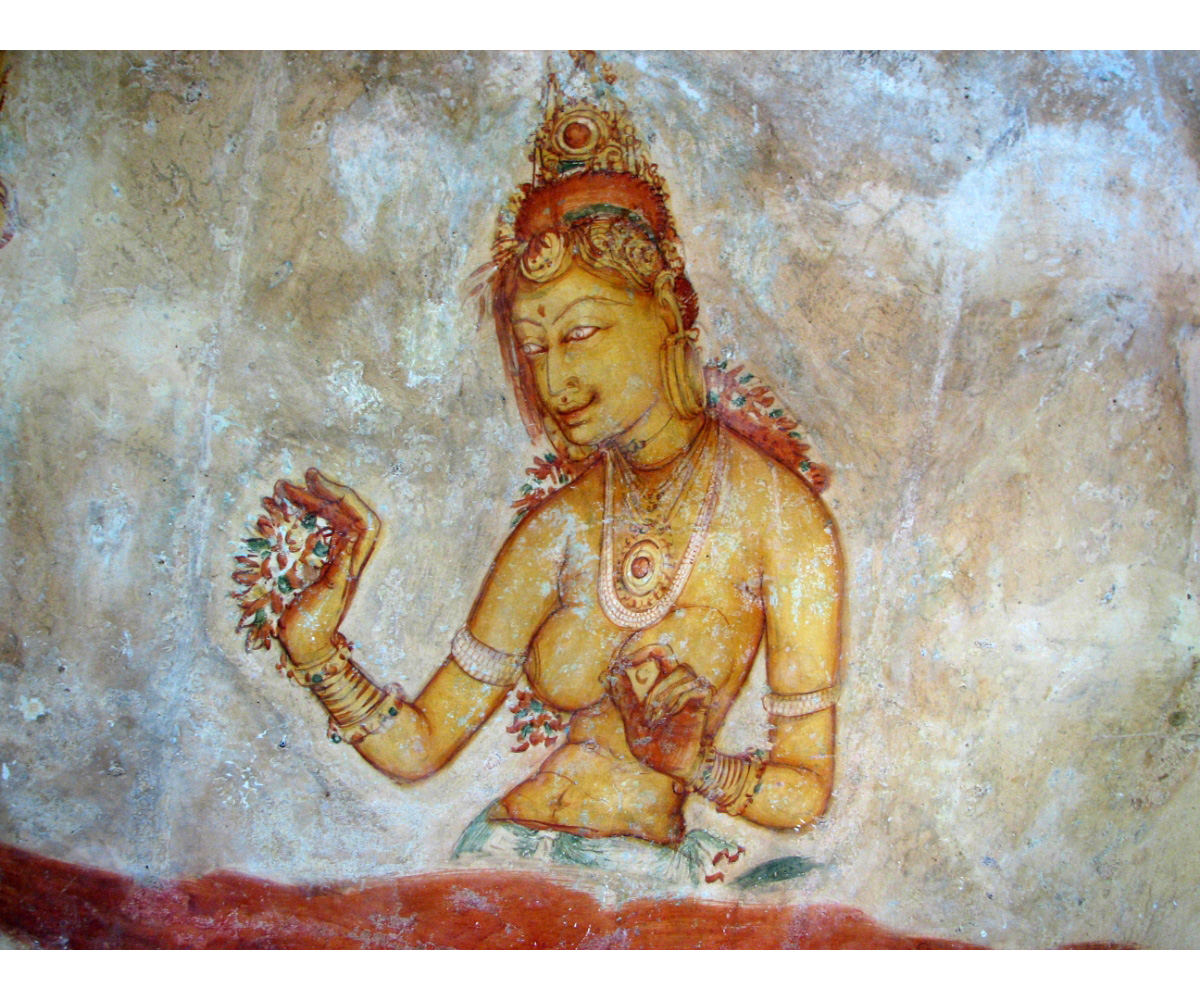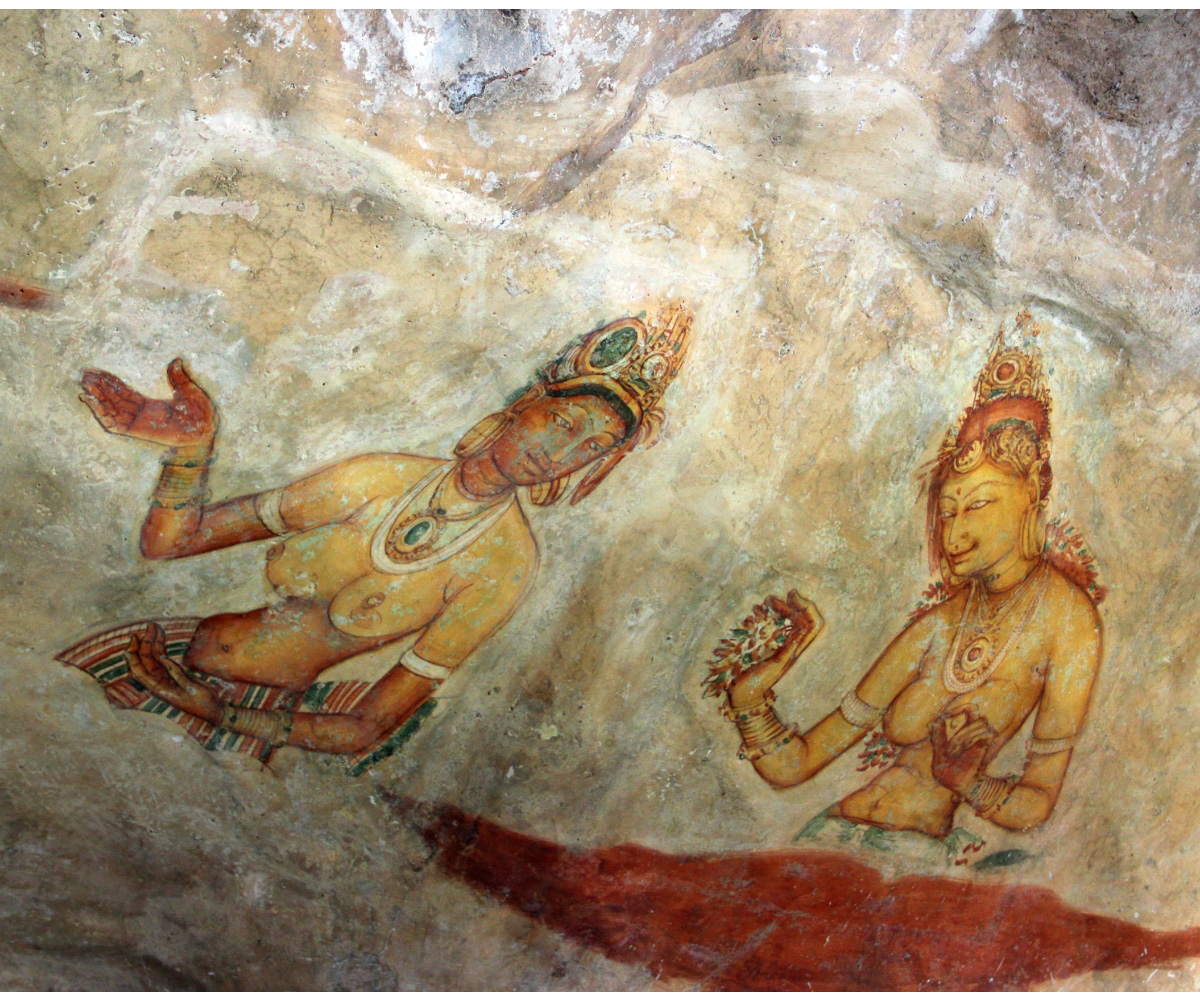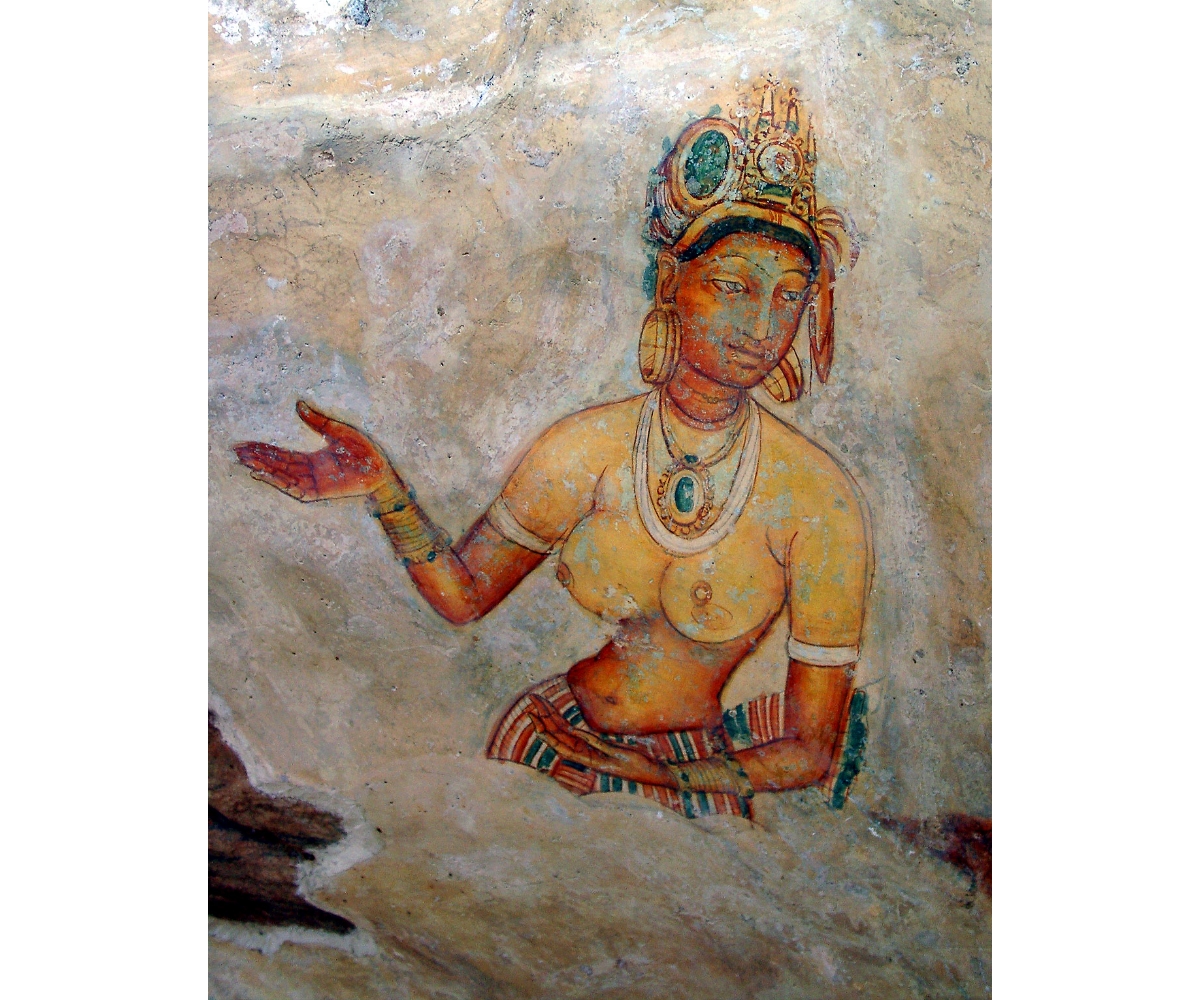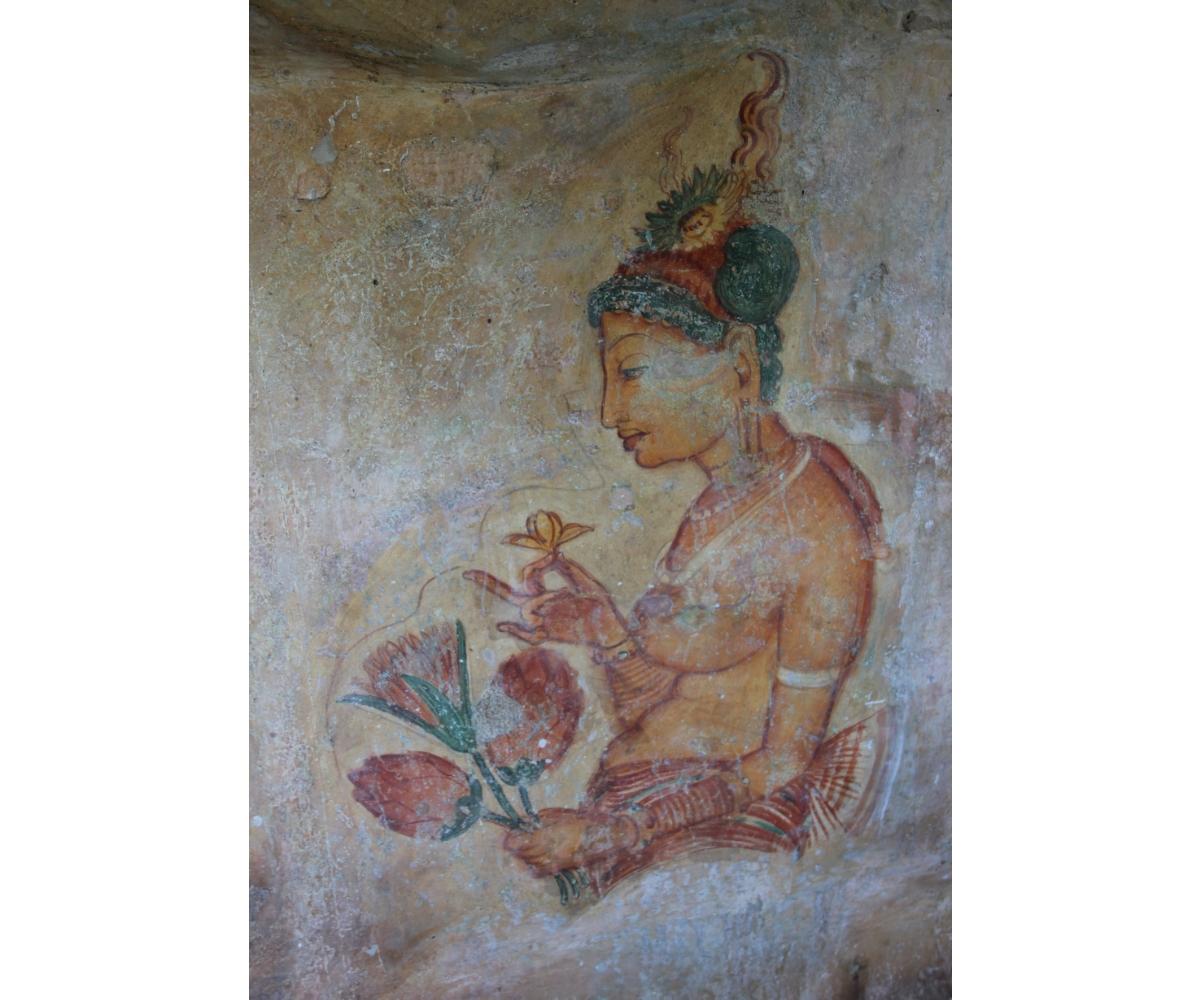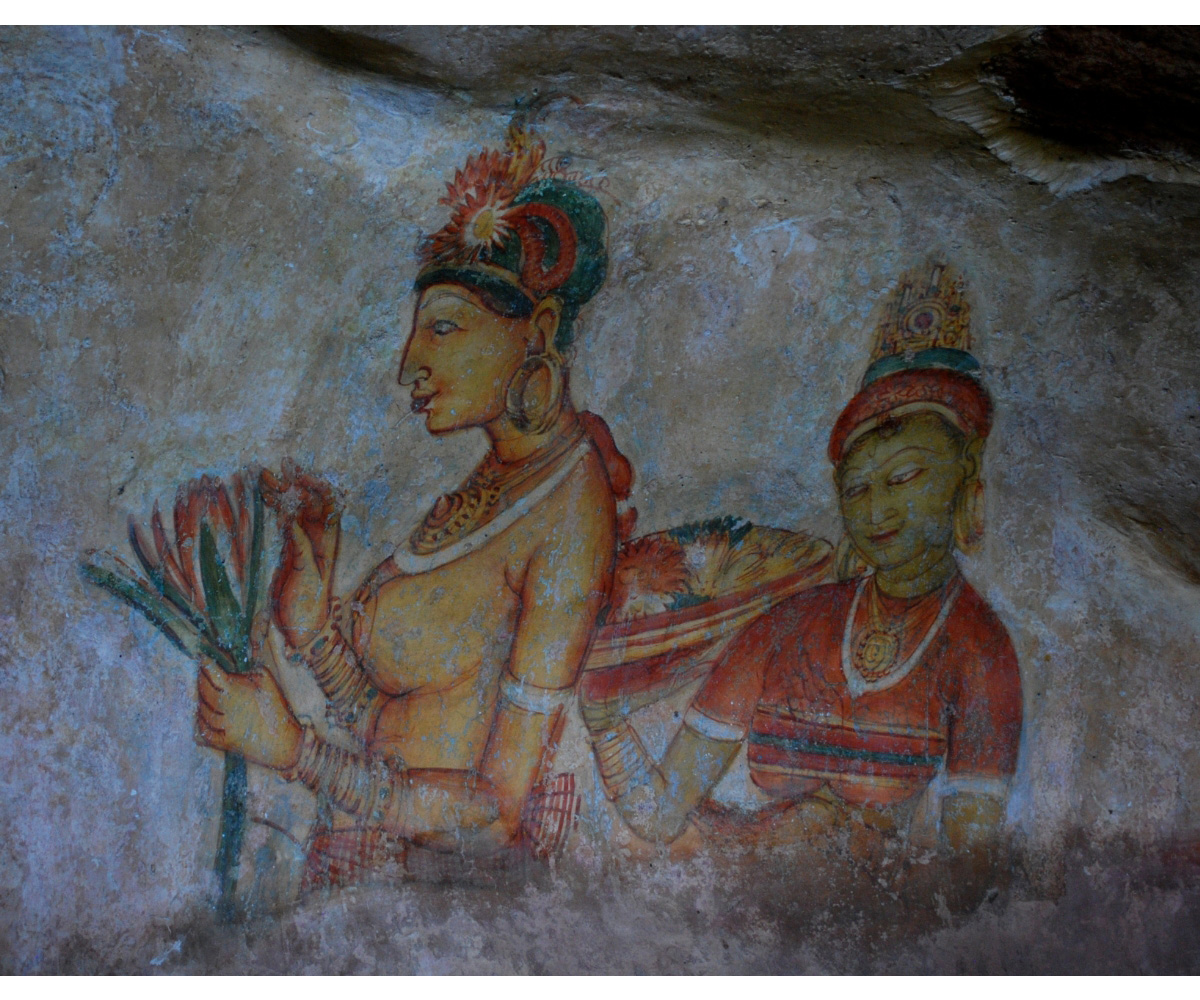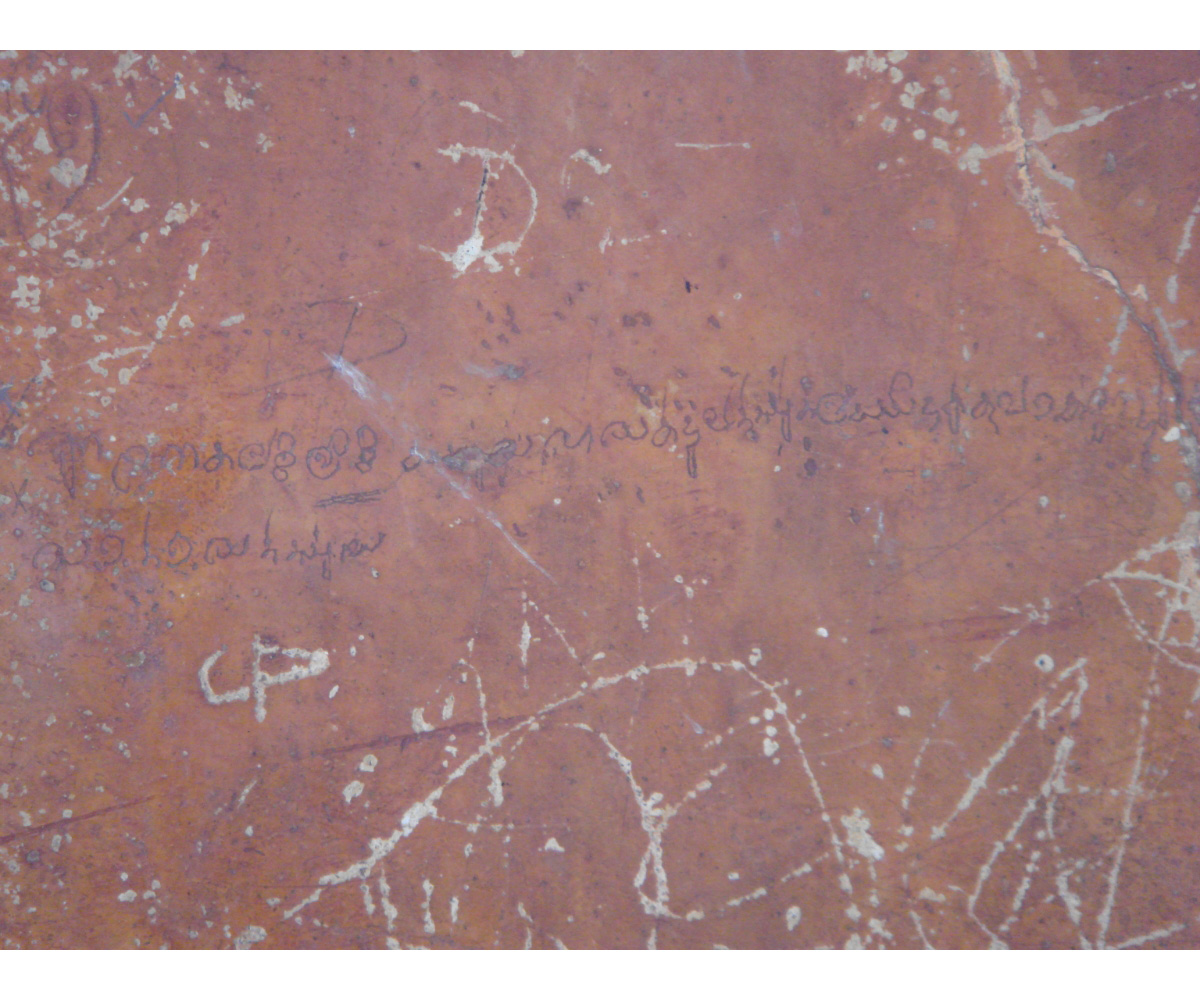PERSPECTIVES
Desires, Reactions, Interpretations: Murals and Inscriptions from Sigiriya
She stopped me feeling sad.
Then took off
to the rugged peak of a mountain precipice.
Joined a happy commune.
Everlasting, indeed!
Why can’t I simply fall asleep
This love-lorn verse comes to us from an array of seventh to thirteenth century Sinhalese inscriptions on the cliffside at Sigiriya, the historic rock fortress in central Sri Lanka. Part of the rock fortress’s western face is decorated with delicate murals depicting graceful women who seem to alleviate sadness and steal the sleep of their male beholders. Today, only twenty-two of these figures remain, although scholars believe that there were originally hundreds of them covering the rock face at the site. Amongst the oldest and most fantastical picture galleries of the ancient world, the Sigiriya frescoes sit six hundred feet above dense tropical jungle. They were painted using natural and mineral pigments, some time around the fifth century CE.
Sigiriya is heavily fortified on all sides with concentric moats and walls, and served as the capital of Moriya king Kassapa in the fifth century CE. He had this new capital built after killing his father and driving his brother, the rightful heir, into exile in South India. The Culavamsa, a Pali historical chronicle of the dynasties of Sri Lanka, tells us that facing public outrage and fearing attack from his brother, Kassapa fled from the erstwhile Moriya capital Anuradhapura to the more remote and secure Sigiriya. He built Sigiriya as an earthly Alakamanda, the Buddhist city of the gods, and is said to have lived there like Kubera, the god of wealth and king of the yakshas in the Buddhist, Hindu and Jain pantheons. Like the towering cliffs of Sigiriya, Alakamanda is said to be a divine city at a high elevation, surrounded by dense, swirling clouds, much like the painted clouds of the Sigiriya frescoes from which beautiful women emerge, gazing down at the viewer in the gallery below.
These women with golden-hued skin, delicate tapering limbs, and languid half-closed eyes are heavily ornamented, and wear elaborate headgear and translucent jewel-toned garments. Sometimes bare chested, several of them appear in pairs, tending to one another, while others are depicted alone, holding flowers or trays of offerings.
Popular belief and scholarly investigation alike have interpreted the enigmatic presence of these images on the rock face in multiple ways. One popular narrative is that the paintings are inspired by Kassapa’s many concubines and their lives. Ananda Coomaraswamy opined that these images are likely representations of apsaras or celestial nymphs, whereas Senarath Paranavithana believed that the women were depicted as personifications of the dark clouds and lightning of Alakamanda, the lofty abode of Kubera. None of these theories are conclusive, however.
The eroticism of these figures is recognisable to anyone who is familiar with ancient and medieval art across South Asia. The widespread depiction of nude or semi-nude women with exaggerated breasts or hips across the ancient and medieval world has elicited diverse interpretations from scholars. Many read the voluptuousness of these figures as suggestive of the principles of abundance and fertility, evoking a life-giving goddess. Others suggest that the sexualised arrangement of the figures betrays the artists’ masculine imagination.
However, besides these scholarly interpretations, we also have access to interpretations by visitors of the Sigiriya paintings. The murals are special in that they are accompanied by hundreds of graffiti inscriptions from the medieval period — verses, couplets and one liners — that record centuries of reactions and interpretations by people who visited the site, which was converted into a Buddhist monastery after Kassapa’s death. These inscriptions are located 44 feet below the frescoes — at a height that pilgrims and passers-by could have accessed, on a wall known as the Mirror Wall because of its highly polished surface. They convey adoration, criticism and wonder, reflecting the spectrum of thought and opinion in Sigiriya’s medieval audience.
Often these amateur poets would pick one woman as the subject of their verse, highlighting her mysteriousness or aloofness and clamouring for her attention. Some of these authors reported prostrating themselves in front of these women.
…..Let it be so;
(my) mind is agitated on seeing these golden-coloured ones and,
being shot at, whilst going, by their askance look,
I lay prostrate on the floor of the rock
One visitor even recorded himself to be thoroughly enticed by the graceful sway of their hips; his verse imagines the women speaking in a suggestive, inviting voice:
“Don’t be shy honey, look at my hips.
Fine, he didn’t run away!”
That boor probably hurt and insulted her
Amongst the authors of the inscriptions are also monks who interpreted these murals allegorically. One Buddhist monk wrote that the beauty of the women in the murals was a reflection of their good deeds, noting also the transient nature of earthly desires and advising his fellow viewers to temper their attraction: “When desires fade, so will affection,” he wrote. Buddhist interpretations abound in the etchings on the Mirror Wall; one writer named Kiti warns against infatuation for the painted women as attachment breeds pain according to Buddhist teachings.
Didn’t I, Kiti, write this?
If you dally,
Don’t lose your heart.
Pleasure leads to pain.
Pain resembles pleasure
Another common theme across these inscriptions is that these nyph-like women, immortalised in stone, were stony-hearted as they mutely observed the predicament of their male admirers. But some visitors speculated that the vagaries and contingencies of life in a courtly harem may have affected the painted women. One commentator wrote that these golden girls had “hurled themselves from the cliff” upon the death of their king. Another pondered on their unfaithfulness since they were dressed in fabulous jewels and silks even after their king’s passing. Yet another is sympathetic towards these women. In the presence of hundreds of admirers, “who could expect them to remain true to an absent lord?” the visitor mused.
Twelve verses attributed to women have been found at the Mirror Wall, but it is possible that they were written by men under female pen-names. In any case, these inscriptions are telling. Six of them look at the painted woman sympathetically. One women identifies with the painted figures and writes a short, drily humorous verse:
As a woman, I feel for the painted ones.
You dumb men, trying so hard to write songs.
None of you brought us rum and molasses
This anonymous woman’s identification with the images stands in contrast with some of the other responses — her identification is sympathetic but not pitying. Her verse places a critical, subtly mocking voice in the mouths of the painted women; we see here a comment on societal relations between men and women, and the writer’s own dissatisfaction with men, displaced onto the figures in the collective “us.”
In a less sophisticated vein, some women visitors seem to have been jealous of the painted beauties and their bodies that were so alluring to their husbands; one Deva, wife of Mahamata, wrote: “That doe eyed dame on the cliff makes me mad. She dangles her pearls and flirts with my husband.” Many verses attributed to women however, are no different in content when compared to the ones written by male visitors — they too deal with themes like the separation from the king. Sivakala, wife of Utur, writes about the golden women throwing themselves from the top of the cliff due to the grief caused by the king’s absence.
These murals, and the text that accompanies them, lend us insight into the dynamism of ancient and medieval artistic and literary cultures of South Asia. In these inscriptions we see proof of a literary culture of response and improvisation in medieval Sigiriya. While it can be said that the varied responses to the murals sheds light on how Sigiriya’s medieval audience reacted to depictions of female sexuality, these inscriptions are not interesting purely from an ethnographic or historical viewpoint; they are interesting also because they challenge our modern impulse to read these murals as either patriarchal sexual fetish or ritualistic, mythological imagery.
The female nude or semi-nude figure is a particularly vexing problem in our interpretations of pre-modern art, especially after modern feminism. Too often we reduce the understanding of pre-modern art to simplistic frameworks: whether ritualistic, or purely sensual, or perhaps political and courtly or even deeply spiritual — depictions of beautiful women have been read in all of these ways and more. We tend to see interpretive range and ambiguity as a defining feature only of modern art. But art has always had a multitude of purposes and evokes myriad reactions in the minds of audiences across centuries and across social categories.
The inscriptions on the Mirror Wall at Sigiriya take us behind the scenes of historical viewership which is often overlooked in our deliberations on pre-modern art. The paintings continued to elicit strong responses even into modern times; as recently as 1967, an unknown perpetrator splattered green paint on the frescoes in an attempt to destroy them, presumably offended by the sensuality of the images. Our responses and reactions to art are shaped by our ideology and our social positions as much as they are shaped by the art itself; at Sigiriya, people have interacted with an enigmatic work of art for centuries, leaving behind a unique, fascinating record of viewership and response.
Bibliography
Kumar-Dumas, Divya. “Reading Architecture in Landscape: Visitor Reflections at a Mirror Wall (Sigiriya, Sri Lanka)” in Art, Architecture, and the Moving Viewer, c. 300-1500 CE, edited by Gillian B. Elliott and Anne Heath, 150-184. Leiden: Brill, 2022
Jha, Mandakini, Gupta, Ila, and Jha P.N. “From Caves to Miniatures: Portrayal of Women in Early Indian Paintings.” Chitrolekha International Magazine on Art and Design 6, no. 1 (2016): 22-42.
Murphy, Richard. “The Mirror Wall.” Grand Street 8, no. 3 (1989): 18–25. https://doi.org/10.2307/25007224.
Williams, Joanna. “The Construction of Gender in the Paintings and Graffiti of Sigiriya” in Representing the Body, edited by Vidya Dehejia, 56 – 67. New Delhi: Kali for Women, 1997.
Paranavithana, S. “SĪGIRIYA Graffiti: Earliest Extant Specimens of Sinhalese Verse.” The Journal of the Ceylon Branch of the Royal Asiatic Society of Great Britain & Ireland 34, no. 92 (1939): 309–49.
Paranavithana, S. “The Significance of the Paintings of Sigiriya.” Artibus Asiae 24, no. 3/4 (1961): 382–87. https://doi.org/10.2307/3249238.




